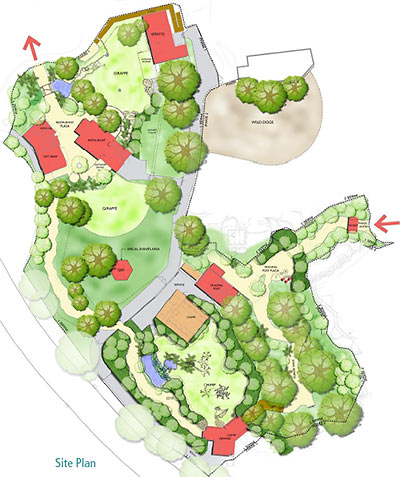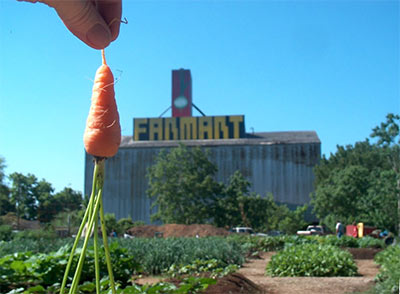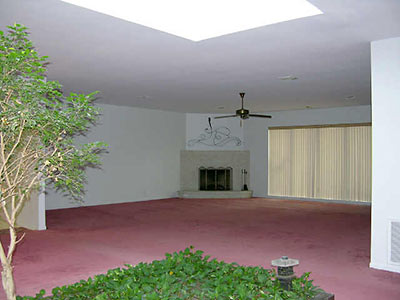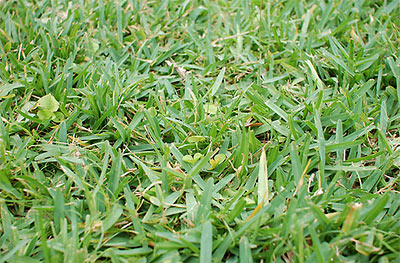JOHN TEAS, 1934-2009 That 1916 house on Teas Nursery property at 4400 Bellaire Blvd. — now home to the company’s landscaping business — was his birthplace. He died yesterday. “His grandfather, Edward ‘Papa’ Teas, Sr., whose family had been in the nursery business since 1843 starting in Indiana, moved his family to Bellaire from Missouri in 1910 to grow and sell produce, but turned to landscaping when a freeze in 1913 wiped out his business. He was responsible for introducing azaleas and crepe myrtle to the area, so legend goes, and for planting some of Houston’s enduring natural beauty, including Rice University’s oaks. John Teas helped plant the oaks along the Rice campus on Fannin Street as a boy. The family’s nursery businesses extended from Fort Bend County through Conroe, but the roots were sunk the deepest in Bellaire, where the nursery and landscaping business continue to this day.” [Bellaire Examiner]
Tag: Landscape
MEASURING PROGRESS IN CUBIC FEET PER SECOND “Also, over the past 50 years, high-impact building and roadway development have reduced the amount of permeable surface to accept stormwater, increasing flooding and pollution. Stream flow speeds in Houston, for example, have increased from under 5,000 cu ft per second in 1930 to about 27,500 cfs in 2000, says the U.S. Geological Survey. With stream-flow increases come a greater potential for flooding. The actual stream flow from 2001’s Tropical Storm Allison in Houston’s Brays Bayou peaked sharply at about 34,000 cfs, 20 hours from the start of runoff. This compares to a more gradual stream flow in 1915, before development. . . . Allison, which caused $5 billion of damage in Houston, would have been a nonevent even 50 years ago because the natural landscape would have absorbed the water, say sources.” [GreenSource]
COMMENT OF THE DAY: HOUSTON’S ROOM TO SPREAD OUT “. . . We by far are not paving our wilderness in concrete. The Katy Prairie represents and extremely small portion of area getting developed. The land you see in the Katy Prairie exists throughout south central Louisiana were it’ll likely never be developed. The Texas Coastal plains is quite undeveloped also. All this crying over really nothing. Wildlife is quite more adaptable than we give them credit for and they’ll move easily where they have to. I’m more and more convinced that people that live in Houston that go after developers for building the outer suburbs don’t realized how much is not developed when they leave the city. I guess they fly everywhere versus drive. The drive from Houston to Dallas alone should demonstrate how uninhabited this state is. Better yet, drive US 59 in either direction from Houston.” [kjb434, commenting on Investing in the Grand Parkway]

 Sure, “immersive landscapes” — where visitors are supposed to feel like they’re just hanging out with the chimps and rhinos and giraffes in the wild — are the latest craze in zoo design. But what’s really the most innovative aspect of the new 13-acre African Forest the Houston Zoo is planning for its southernmost quadrant, at the intersection of North MacGregor and Golf Course Dr. in Hermann Park?
Sure, “immersive landscapes” — where visitors are supposed to feel like they’re just hanging out with the chimps and rhinos and giraffes in the wild — are the latest craze in zoo design. But what’s really the most innovative aspect of the new 13-acre African Forest the Houston Zoo is planning for its southernmost quadrant, at the intersection of North MacGregor and Golf Course Dr. in Hermann Park?
The project
. . . will feature closed-circuit TV connections with area hospitals, allowing patients to view animal keeper presentations or simply to watch animals in their near-natural habitats.
[Houston Zoo President Deborah] Cannon said the programs first will be made available to children’s hospitals, then expanded. Ultimately, they may be made available to local schools, she said.
At last, an effort to capture some of that technological synergy swirling around the Houston Zoo-Med Center nexus! Best of all is the Chronicle‘s own map identifying the project’s location, which is a gift to the city all by itself:
FARMING OPPORTUNITIES IN THE FIFTH Inspired by a visit to a South Florida demonstration farm that emphasizes resourcefulness — “they’ve built things like a well pump from simple bicycle parts, irrigation systems from cinder blocks, and terraces from old tires,” he notes — summer resident James M. Harrison begins “to notice similar ways that people in Houston’s Fifth Ward are harvesting their own backyard crops. Just up the block, one of my neighbors is growing banana trees on his driveway. He’s been able to do it by building a raised bed from cinder blocks against a fence, and using soil that he composts in his backyard. A couple of days ago, we collected basil leaves from the neighbors herb garden, and used them to make pesto. It went great with the tomatoes from our own back yard. And over the weekend, I snacked on figs, cucumbers, and citrus in a Community Garden on Houston’s south side with some friends.” [Neighborhood //#5]
GROWING UP GRASS-FREE IN NORTH NORHILL “Kids don’t need yards- not grassy ones anyway. For a 2 year old, concrete is complete perfection. He practices his tricycle riding. He pushes Tonka trucks at near warp speed. We inflate ‘the pool’ with no worries of it killing the grass underneath. Balls bounce and bubbles pop and sidewalk chalk art covers every inch of visible ground. We just had another baby- another boy. Like our 1st, the new one will lay on a blanket on the deck. He’ll be shaded by the car port and we’ll have no fear of accidentally laying him down in a bed of fire ants. We bought our older son a giant playhouse to help occupy him while we are attending to the demands of a newborn. It has a gas station on one side and his little scooter can easily glide down his ‘road.’ The basketball hoop on the other side benefits from a hard bouncing surface.” [The Heights Life]
 Spotting the first bloom of the season on the crape myrtle she and her husband planted way back when at their Meyerland home brings up fond memories for homeowner Annie Sitton:
Spotting the first bloom of the season on the crape myrtle she and her husband planted way back when at their Meyerland home brings up fond memories for homeowner Annie Sitton:
When we planted this tree, it was about ten feet tall with a large root ball. We’ve all seen bad guys in movies digging graves. They make it look so easy. Well, let me tell you…digging even a small hole in the earth is difficult work. When it was my turn at the shovel, I couldn’t believe the energy it took. After about ten minutes into my digging career, my shovel hit something hard…clunk. I screamed, “Buried treasure!” I had always said there was something special about this piece of land.
Oh . . . there was!
NEIGHBORHOODS NOT PAYING FOR NO FRONT-YARD PARKING NOTICES Civic clubs won’t have to shell out thousands of dollars for postage if they want to apply for a front-yard parking ban after all, the Chronicle‘s Bradley Olson reported last week: “After the neighborhoods balked, the planning department purchased equipment that will allow it — instead of neighborhoods — to send bulk mailings. The department estimates it will pay $15,000 to $20,000 in mailing costs in the first year and $125,000 over five years for the bulk mailing equipment. ‘I’m really excited that the administration listened to the voices of the homeowners and the civic associations,’ said Councilman James Rodriguez, who pushed for city to revise its stance. As of [last] Thursday afternoon, the planning department had received four applications, all from neighborhoods in the Spring Branch area.” [Houston Chronicle, previously in Swamplot]
PROBLEMS WITH THE FRONT-YARD PARKING POSTAGE METER Houston’s opt-in-only front-yard parking ban, which goes into effect next week, is already proving popular with neighborhood groups — but expensive. “The current application requires civic clubs to pay for first-class mailings to every property owner that would fall under the parking ban. ‘We’re seeing whole neighborhoods come in (to apply), like 5,000 residences,’ said Planning Department spokeswoman Suzy Hartgrove. ‘We underestimated the magnitude of the interest in the program. We weren’t fully budgeted for this, and this was a way for neighborhoods to share the cost.’ . . . Sharpstown, for example, has more than 6,800 homes. Informing all the owners through a first-class mailing would cost at least $3,000. Milton Winebrenner, the Sharpstown Civic Association president, said he is asking the city to allow them to do a bulk-rate mailing. Other neighborhood leaders want to know why they cannot use their regular homeowner association newsletter to inform residents.” Or hey, why not just use Swamplot? We’ll post keep-off-your-lawn notices for free! [Houston Chronicle; previously in Swamplot]
COMMENT OF THE DAY: BURIED LANDSCAPES OF THE HOUSTON HEIGHTS “Before developers established the heights and its various neighboring subdivisions, a massive filling project took placed. It was pretty much a landfill for the City of Houston. . . . Developer clear cut the existing pine forest (the oaks pretty much only existed near the bayous and tribs) and filled in the uneven landscape. A big example is in Woodland Heights. A 60-inch storm sewer line runs in an old trib to White Oak Bayou. The line is 20-ft below the current natural ground in the area. After the line was built, the natural channel was filled in and streets placed on top. The line currently goes under many people properties and houses and many don’t know it exists. . . . Outside of that, several ox bows and other trib were filled in. A couple were not though. There is one just east of TC jester where it cross White Oak Bayou south of 11th. It has water in it. There is another just west of Yale that is dry. I’ve seen historic photos showing people jumping off the banks of the the natural streams in the bayous in the Clark Pines area (14th street west of Durham). A current development is actually being build on an undeveloped piece of land that was a site of the landfill in this oxbow. The houses are being placed on piles driven deep into the ground to avoid them from sinking or collapsing. I doubt they are telling the home buyers this. Long time residents know about it though.” [kjb434, commenting on Wet and Wild: Strip Redo on White Oak]
Last year Transit Antenna, a 7-person “mobile living experiment,” camped out at Joe Nelson Icet’s Last Organic Outpost, did a little farming, and painted the giant “FARMART” mural at the top of the adjacent Comet rice mill. The group, which travels the country on a city bus converted to run on waste vegetable oil, documented its visit — which included a stint in the Art Car Parade — in a series of website posts.
And not long after the rambling group left its urban campground, Transit Antenna’s Seth Gadsden posted this half-hour documentary the group put together about goings-on at the Emile St. farm and its Fifth Ward neighborhood. An HD version is also available.

The Lower Fifth Ward urban farm known as the Last Organic Outpost is set to expand again from its growing campus at 700 Emile, reports founder Joe Nelson Icet:
We are presently working on the Buck Street expansion and hope to get more dirt soon to add to the existing 32 beds we already have growing.
Across the street from the 711 Emile gate, there is a lot up for public auction March 2nd that we hope to farm in the near future. This lot is currently being used for dumping. Also at 4610 Gunter, there is a lot that has been cited by the city for high grass. We would like to take stewardship of these lots for creating a 5th Ward Farm Belt.

“SPACIOUS LIVINGROOM WITH SKYLIGHT & FLOWERBED,” shouts the listing for this 1970s-era home on a cul-de-sac near White Oak Bayou in Candlelight Forest. And it’s no exaggeration. The Swamplot reader who alerted us to the property also expressed appreciation for its mauve carpet and mirrored Dining Room wall:
A BRIGHT FUTURE FOR STREET BUSHES “A proposed ordinance before council would prohibit the planting of tall trees, including live oaks, under power lines. The measure originally was intended to strengthen existing rules to protect trees in public rights of way from being cut down or hacked up by developers. But the proposed ban on planting live oaks under electric lines — a last-minute addition to the measure — has a vocal group of tree lovers dismayed. Their main complaint centers on the live oak’s usefulness for hiding power lines. ‘If this were to pass, we would have to look a lot more at the ugliest feature of our city: power lines,’ said Hugh Kelly, a former general counsel for Houston Light & Power who advocated against the change on behalf of two neighborhood groups. ‘And we would not be able to look at one of the prettiest features: live oaks.'” [Houston Chronicle]

Been worried that those neighbors of yours have been ruining the delicate balance of petroleum-based fertilizers in their grass with slow oil leaks?
Help is on the way! City Council has passed an amendment to Houston’s parking ordinance that will allow neighborhoods to apply individually for local 20-year bans on front-yard parking.
Signatures of 60 percent of a neighborhood’s residents are required to enact a ban, and restrictions can be appealed. But Intermodality blogger Christof Spieler, who’s been following lawn-parking-ban efforts for some time, notes neighborhoods that don’t have fussy deed restrictions already in place might want to think twice before signing up:
This new version also allows for the use of permeable paving. But it does not address the other problem: ultimately, this is an incentive to pave more. If your neighborhood opts in, you won’t be able to park on your front lawn. But, unless there’s a specific deed restriction in place against it, you’ll be able to pave your front lawn and the park there.
- City Council cracks down on cars in yards [Houston Chronicle]
- The lawn wait is over [Intermodality]
Photo: Flickr user herbinhouston

